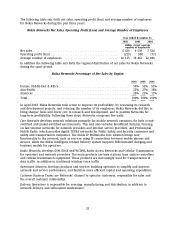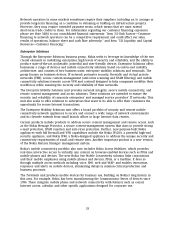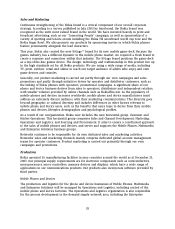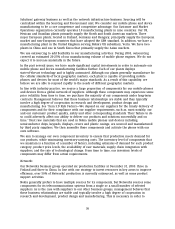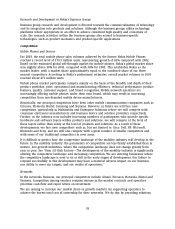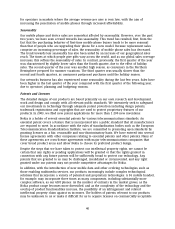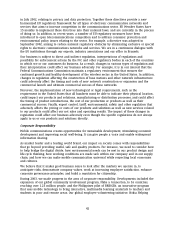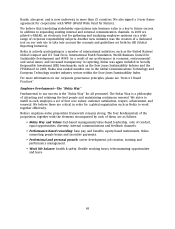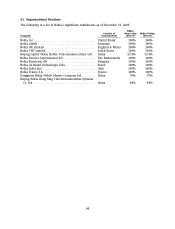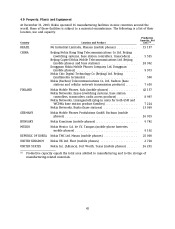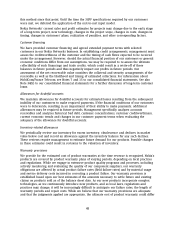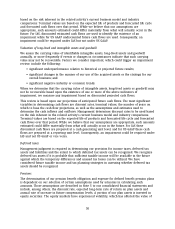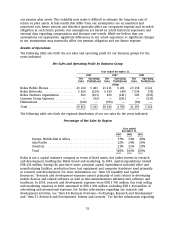Nokia 2003 Annual Report Download - page 42
Download and view the complete annual report
Please find page 42 of the 2003 Nokia annual report below. You can navigate through the pages in the report by either clicking on the pages listed below, or by using the keyword search tool below to find specific information within the annual report.terms. In addition, although we endeavor to ensure that companies that work with us possess
appropriate intellectual property rights, we cannot fully avoid risks of intellectual property rights
infringement created by suppliers of components and various layers in our products and solutions
or by companies with which we work in cooperative research and development activities.
Similarly, we and our customers may face claims of infringement in connection with our
customers’ use of our products and solutions. Finally, as all the technology standards, including
those used and relied on by us, include some intellectual property rights, we cannot fully avoid
risks of a claim for infringement of such rights due to our reliance on such standards. It is
therefore more likely that we will be required to obtain additional licenses or that some of the
components or layers in these handsets, or other products or solutions of ours, will be protected
by intellectual property rights of which we are unaware, potentially causing us to infringe the
rights of others.
The business models for mobile services have not yet been established in many aspects. The
unavailability of licenses for copyrighted content, delayed negotiations or restrictive copyright
licensing terms may have an adverse effect on the cost or timing of content-related services by us,
operators or third party service providers, and may also indirectly affect the sales of our handsets.
From time to time we are subject to patent claims from third parties. We believe that, based on
industry practice, any necessary licenses or rights under patents that we may require can be
obtained on terms that would not have a material adverse effect on our business, results of
operations or financial condition. Nevertheless, necessary licenses may not be available on
acceptable terms, if at all. The inability to obtain necessary licenses or other rights or the need to
engage in litigation could have a material adverse effect on our business, results of operations and
financial condition. See ‘‘Item 3.D Risk Factors—Our products and solutions include increasingly
complex technology involving numerous patented and other proprietary technologies. As a
consequence, evaluating the protection of the technologies we intend to use is more difficult than
before, and we may face claims that we have infringed third parties’ intellectual property rights.
The use of increasingly complex technology may result in increased licensing costs for us,
restrictions on our ability to use such technology and offer our products and solutions, the
invalidation of intellectual property rights on which we depend and/or costly and time-consuming
litigation.’’
Government Regulation
Our products are subject to various Federal Communications Commission, or FCC, regulations in
the United States. FCC regulation of the commercial mobile radio service industry has a direct and
substantial impact on our business. It is in our interest that the FCC maintains a regulatory
environment that ensures the continued robust growth of the wireless sector in the United States.
FCC type acceptance regulations require that our products meet specified radio frequency emission
standards and not cause unallowable interference with other services. It is very important to our
business that the FCC, along with other US government agencies, take actions to ensure that
sufficient spectrum is made available to meet the demand for advanced wireless products and
solutions. In addition, a continued deregulatory and pro-competitive approach by the FCC and
other agencies toward the Internet and the delivery of advanced mobile services should allow us
to expand our business operations by offering businesses and consumers new and innovative
mobile communications products and solutions.
EU regulation in many areas has a direct effect on the business of Nokia and our customers within
the single market of the European Union. In February 2002, the Council of Ministers adopted a
telecommunications package consisting of a general framework directive on electronic
communications and services and three specific directives relating to authorization, access and
interconnection, and universal service and users’ rights. A fourth, and final, directive was adopted
41



